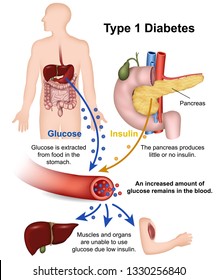What is Type 1 Diabetes?
https://www.diabetesaustralia.com.au/about-diabetes/type-1-diabetes/
Type 1 diabetes
Type 1 diabetes is an autoimmune condition in which the immune system is activated to destroy the cells in the pancreas which produce insulin. We do not know what causes this autoimmune reaction. Type 1 diabetes is not linked to modifiable lifestyle factors. There is no cure and it cannot be prevented.
Type 1 diabetes:
- Occurs when the pancreas does not produce insulin
- Represents around 10 per cent of all cases of diabetes and is one of the most common chronic childhood conditions
- Onset is usually abrupt and the symptoms obvious
- Symptoms can include excessive thirst and urination, unexplained weight loss, weakness and fatigue and blurred vision
- Is managed with insulin injections several times a day or the use of an insulin pump.
What happens to the pancreas?
In type 1 diabetes, the pancreas, a large gland behind the stomach, stops making insulin because the cells that make the insulin have been destroyed by the body’s immune system. Without insulin, the body’s cells cannot turn glucose (sugar), into energy.
People with type 1 diabetes depend on insulin every day of their lives to replace the insulin the body cannot produce. They must test their blood glucose levels several times throughout the day.
The onset of type 1 diabetes occurs most frequently in people under 30 years, however new research suggests almost half of all people who develop the condition are diagnosed over the age of 30. About 10-15 per cent of all cases of diabetes are type 1.
What happens if people with type 1 diabetes don’t receive insulin?
Without insulin the body burns its own fats as a substitute which releases chemical substances in the blood. Without ongoing injections of insulin, the dangerous chemical substances will accumulate and can be life threatening if it is not treated. This is a condition call ketoacidosis.
What causes type 1 diabetes?
The exact cause of type 1 diabetes is not yet known, but we do know it has a strong family link and cannot be prevented. We also know that it has nothing to do with lifestyle, although maintaining a healthy lifestyle is very important in helping to manage type 1 diabetes.
At this stage nothing can be done to prevent or cure type 1 diabetes.
Symptoms
- Being excessively thirsty
- Passing more urine
- Feeling tired and lethargic
- Always feeling hungry
- Having cuts that heal slowly
- Itching, skin infections
- Blurred vision
- Unexplained weight loss
- Mood swings
- Headaches
- Feeling dizzy
- Leg cramps.
These symptoms may occur suddenly. If they occur, see a doctor. Through a simple test, a doctor can find out if they’re the result of type 1 diabetes.
Management, care and treatment
Type 1 diabetes is managed with insulin injections several times a day or the use of an insulin pump. While your lifestyle choices didn’t cause type 1 diabetes, the choices you make now can reduce the impact of diabetes-related complications including kidney disease, limb amputation and blindness.
If you have recently been diagnosed with type 1 diabetes or have a family member with type 1 diabetes, view information on managing type 1 diabetes.


Comments
Post a Comment